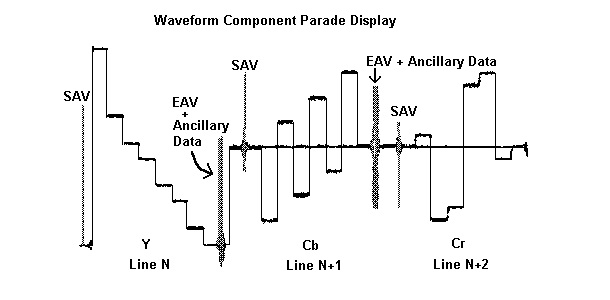
Three signals in - R,G,B and three signals out
Y or Luminance (black & white portion of the signal) = 30% Red, 69% Green, and 11% Blue
B - Y (also called Pb) literally means take whatever is in the Blue channel and subtract everything from the composite Y signal
R - Y (also called Rb) literally means take whatever is in the Red channel and subtract everything from the composite Y signal
See page 195

Vector color space - The dots represent the various colors found in the color bar signal
The circle represents color space. The farther from the center the more saturated the color
Where around the circumference determines the tint or color
The R - Y signal determines where on the X axis, and the B - Y determines where along the axis a particular color point lands
Here is a "parade" display of one line of Y, one line of B-Y, and one line of R-Y
SAV = Start of Active Video; EAV = End of Active Video
SAV & EAV are the reference signals that represent exactly what their name implies
Engineers refer to digital signals often as simply number sequences. Here is a display that illustrates this.
The arrow points to a digital sample (word) that has all its bits high. The next two samples are all zero.
This signifies either an EAV or SAV. Only these two items are allow to use all bits high (all 1s) and all bits low (all bits 0).
The following sample determines if the preceeding three words represented a EAV or SAV.
The waveform above is analog in nature and going from all bits on to all bits off is what causes the "ringing" at the EAV/SAV points.

This illustrates that when looking at individual horizontal lines on a waveform monitor the Cb (B-Y) & Cr (R-Y) displays are actually
one line lower for Cb, and two lines lower for Cr than the Y line.